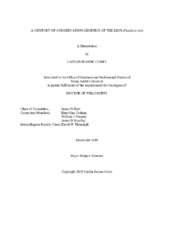| dc.contributor.advisor | Derr, James N. | |
| dc.creator | Curry, Caitlin Jeanne | |
| dc.date.accessioned | 2020-09-09T20:46:19Z | |
| dc.date.available | 2021-12-01T08:43:30Z | |
| dc.date.created | 2019-12 | |
| dc.date.issued | 2019-08-14 | |
| dc.date.submitted | December 2019 | |
| dc.identifier.uri | https://hdl.handle.net/1969.1/189012 | |
| dc.description.abstract | Lions are a flagship species, meaning that as a large, charismatic carnivore, research and conservation for the lion influences many other species that share its habitat. Proper management requires understanding of a species’ genetic history and the amount of variation that exists across its range. Knowing trends in genetic diversity in the lion will help in making decisions on where and how to manage lions and other wildlife populations. With the use of modern biotechnology, I determined the genetic architecture of both historical (>100 years ago) and modern (2000 to present) lion populations across the traditional range states in Africa and Asia. Both datasets were analyzed using the same methods allowing for a more direct comparison over time than has previously been employed. DNA was isolated from high quality and well-documented museum specimens as well as biological material collected from contemporary lions and data from several recently published studies. Fourteen microsatellite molecular markers were redesigned to be specific to the lion then paired with mitochondrial DNA analyses to determine genetic diversity. Genetic diversity was examined to assess local structure in Zambia and to determine range-wide changes to the overall population over the past century. The historical population of lions was panmictic.
But, while most of the current subpopulations of lion assessed in this study are considered to be genetically healthy, they exhibit fine population structure. The dramatic differences between the population structure of the historical and modern population illustrates our need to better understand relationships between the now fragmented subpopulations. Knowledge about the genetic health of the lion has helped us to identify existing wild lion subpopulations that are most at risk and can now be used to make recommendations to guide management actions to safeguard the future genetic health of the lion. | en |
| dc.format.mimetype | application/pdf | |
| dc.language.iso | en | |
| dc.subject | Panthera leo | en |
| dc.subject | lion | en |
| dc.subject | lions | en |
| dc.subject | conservation genetics | en |
| dc.subject | population genetics | en |
| dc.subject | conservation | en |
| dc.subject | mitochondria | en |
| dc.subject | mitogenome | en |
| dc.subject | DNA | en |
| dc.subject | aDNA | en |
| dc.subject | mtDNA | en |
| dc.subject | nDNA | en |
| dc.subject | microsatellites | en |
| dc.subject | miniSTRs | en |
| dc.subject | STR | en |
| dc.subject | genetics | en |
| dc.subject | genomics | en |
| dc.subject | Africa | en |
| dc.title | A Century of Conservation Genetics of the Lion (Panthera leo) | en |
| dc.type | Thesis | en |
| thesis.degree.department | Veterinary Pathobiology | en |
| thesis.degree.discipline | Genetics | en |
| thesis.degree.grantor | Texas A&M University | en |
| thesis.degree.name | Doctor of Philosophy | en |
| thesis.degree.level | Doctoral | en |
| dc.contributor.committeeMember | Murphy, William J. | |
| dc.contributor.committeeMember | Cothran, Ernst G. | |
| dc.contributor.committeeMember | Woolley, James B. | |
| dc.type.material | text | en |
| dc.date.updated | 2020-09-09T20:46:20Z | |
| local.embargo.terms | 2021-12-01 | |
| local.etdauthor.orcid | 0000-0002-3853-7191 | |


